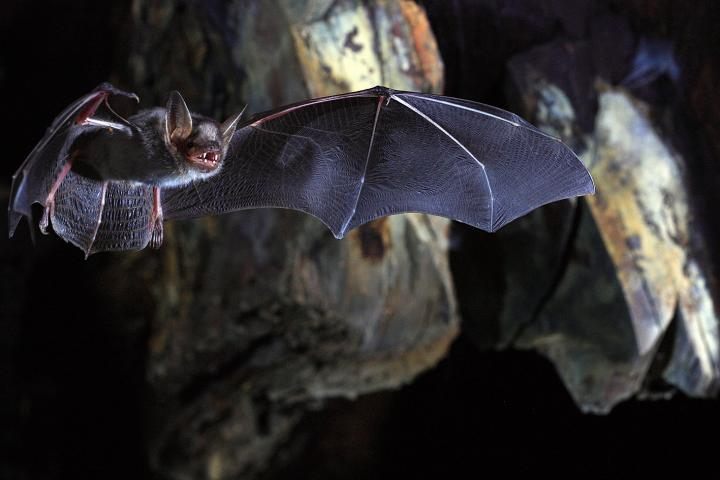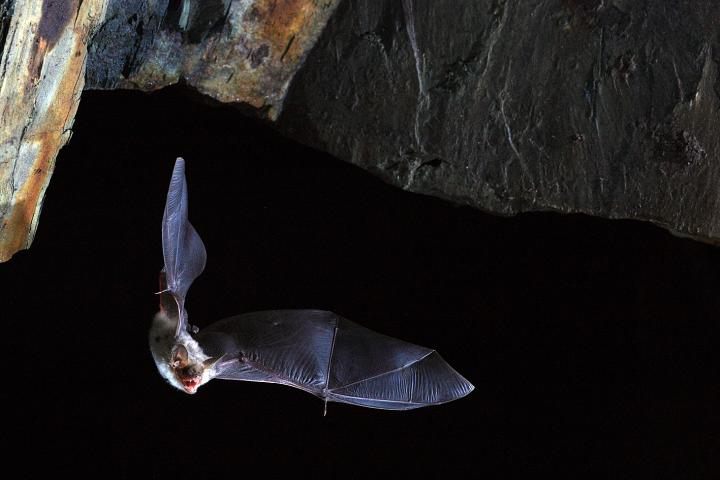The Bats That Never Get Old
They eventually die, but their cells stay forever young.

Cells live busy lives, usually dividing in the vicinity of 50 and 70 times. The divisions are productive, but they also cause collateral damage. Chromosomes are capped with telomeres, and these strings of nucleotides buffer the meatier genetic material as it splices and reattaches. With each cleaving, the telomeres shrink. They replenish themselves for awhile, but over time, they get shorter and stay that way.
Though the cause-and-effect dynamics are a little murky, stubbier telomeres are correlated with aging and mortality. If you make it to old age, your telomeres will likely be less than half the length they were when you entered the world. At least, that’s how it works for humans. For some species of bats, it’s a totally different story—and a pretty interesting one.
Bat species in the Myotis genus tend to intrigue researchers because they defy expectations. In general, “small things live fast and die young,” while “big things live slow and live long,” the biologist Emma Teeling, a professor at University College Dublin, told Motherboard. A mayfly lives a single day; a house mouse generally sees each season once; some whales have dipped fins in multiple centuries. Myotis bats upend this pattern: They weigh between two and 45 grams, and 13 species of them are known to live past their 20th birthdays. The combination of their petite size and long life is remarkable—out of all the mammals on the planet, these bats have the largest disparity between body mass and lifespan. Given its size, a 41-year-old Brandt’s bat, Myotis brandtii, lived roughly ten times longer than scientists might have guessed it would.
A 2013 study in Nature Communications sequenced the genome of the Myotis brandtii, and speculated that a combination of hormones and behaviors—such as hibernation—contribute to it swooping into relatively old age. Now, new research published in Science Advances and coauthored by Teeling adds another piece to the puzzle by looking at those little chromosome caps.

Teeling and other bat biologists harvested three-millimeter samples from the wings of nearly 500 wild bats spanning four species in three genera. (This was no big loss for the bats—the tissue regrows.) From those biopsies, which were either flash-frozen or desiccated, the researchers sampled DNA. The scientists compared these sequences to the genomes of 52 other mammals, and paid special attention to genes associated with telomeres.
In most of the bat species, telomeres appeared to shorten with age, as expected. Not so with the Myotis bats. The length of their telomeres stayed constant over time. “Our results suggest that long-lived bats have evolved better mechanisms to prevent and repair age-induced cellular damage,” Teeling said in a statement.
That doesn’t mean that these bats live forever, of course. Like the naked mole rat, their spiritual cell-death-defying kin, these bats do perish, but from things like dehydration, starvation, or mishaps. Members of this genus rarely die from conditions such as cancer. It’s far too soon to look to the bat to to reveal strategies for extending human life. For now, it’s safe to say that there’s much more to learn about how bats respond to the ticking clock.






















Follow us on Twitter to get the latest on the world's hidden wonders.
Like us on Facebook to get the latest on the world's hidden wonders.
Follow us on Twitter Like us on Facebook